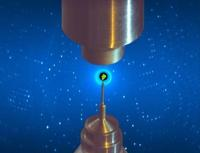Conveners
Protein structure, function and dynamics
- Flora Meilleur
Protein structure, function and dynamics
- Matthew Blakeley
Protein structure, function and dynamics
- Frank Gabel (Insitut de Biologie Structurale, Grenoble, France)
Protein structure, function and dynamics
- Ralf Biehl (Forschungszentrum Jülich)
IDPs are identified by the presence of unfolded region due to relatively
abundant polar residues content within its amino acid sequence. Together
with other residues, IDPs exhibit not only high flexibility but
also sensitivity to physico-chemical fluctuation such as pH, temperature,
and ions concentration. For this reason, IDPs are involved in
cellular processes such as DNA repair scheme...
In-line size exclusion chromatography (SEC) is now routinely offered by a number of small-angle x-ray scattering (SAXS) instruments at synchrotron light sources, particularly those which focus on protein solution scattering, being pioneered on high flux undulator sources. There has recently been a successful demonstration of in-situ SEC-SANS [1, 2] at a reactor neutron source. Here, we...
NADH-cytochrome b5 reductase (b5R) on endoplasmic reticulum membrane in mammalian liver cell plays a variety of roles concerning lipid unsaturation and xenobiotic metabolism. b5R transfers electrons from two-electron carrier of NADH to one-electron donor of cytochrome b5. In the redox cycle of b5R, a hydride transfer from NADH to oxidized FAD and deprotonation from the reduced FADH take place...
Kai-clock system is one of the simplest biological clocks: the system is composed with only three proteins, KaiA, KaiB and KaiC, and they repeat association-dissociation with 24-hrs period as follows, A2+B4+C6 → A2C6+B4 → A2+B6C6 → A12B6C6 → A2+B4+C6 → ∙∙∙. To understand this system, it is essential to reveal the complex structures in every phase. For this purpose, we have been focused on the...
Rubisco (ribulose-1,5-bisphosphate carboxylase/oxygenase) is responsible for photosynthetic CO2 fixation and is the most abundant enzyme on earth. The carbon atoms in every organism in the entire biosphere have passed through the reaction cycle at the active site of a Rubisco enzyme at some point in time. In the photosynthetic CO2 reduction reaction catalysed by Rubisco, atmospheric CO2 is...
Daniele Di Bari1,2,3, Stepan Timr4, Fabio Sterpone4, Alessandro Paciaroni1, Judith Peters2,3.
1Univ. of Perugia, Dep. of Physics and Geology, Italy. 2Univ. Grenoble-Alpes, CNRS, LiPhy, France. 3Institut Laue-Langevin, France. 4Laboratoire de Biochimie Theorique, CNRS, France.
Life on Earth...
Triosephosphate isomerase (TIM) is a key enzyme in glycolysis that catalyses the interconversion of glyceraldehyde-3-phosphate (GAP) and dihydroxyacetone phosphate (DHAP). This simple reaction involves the shuttling of protons mediated by protolysable side chains. The catalytic power of TIM is thought to stem from the ability to facilitate the deprotonation of a carbon next to a carbonyl group...
We have used the ability of neutron crystallography to locate hydrogen atoms in our studies to investigate the mechanisms of the heme peroxidases cytochrome c peroxidase and ascorbate peroxidase. In order to do this we have cryo-trapped the labile intermediates known as Compound I and Compound II in crystals. A key question about these intermediates has been the protonation states of the...
Knowledge of the protein tracer diffusion constitutes a key element to describe intracellular transport, which can be modeled by the self-diffusion in colloid systems. However, it is necessary to test the underlying assumption that neither the protein shape and size nor the polydisperse nature of the cytosol matter. We present a combined experimental and simulation study of the protein tracer...
Upon protein ligand binding, changes of conformational entropy occur in protein and hydration layer. In an experimental study, we investigated the relevance of conformational entropy for the binding of biotin to the protein streptavidin. Using QENS, we investigated changes in conformational entropy between the ligand-free and the ligand-bound state. We compared the internal dynamics of...
Crystallography and cryo-EM have provided new and exciting insight into protein substrate degradation by AAA+ ATPases and the PAN-proteasome system. However, direct structural information on the conformational changes of the working complex, as well as the respective substrate states and populations during the active unfolding and degradation process remain scarce.
Here, we apply...
Two influenza A nucleoprotein variants (wt: G102R; and mutant: G102R and E292G) were studied with regard to macro-molecular interactions in oligomeric form (24-mers). The E292G mutation has been previously shown to provide cold adaptation. Molecular dynamics simulations of these complexes and trajectory analysis showed that the most significant difference between the obtained models was...
Protein function is realized by an interplay of molecular structure and dynamics. Although various methods have been established to study the evolution of macromolecular conformation after trigger events, the time-resolved evolution of protein dynamics on molecular length scales presents experimental challenges, in particular in the native environment in solution [1].
Here, we present a case...

